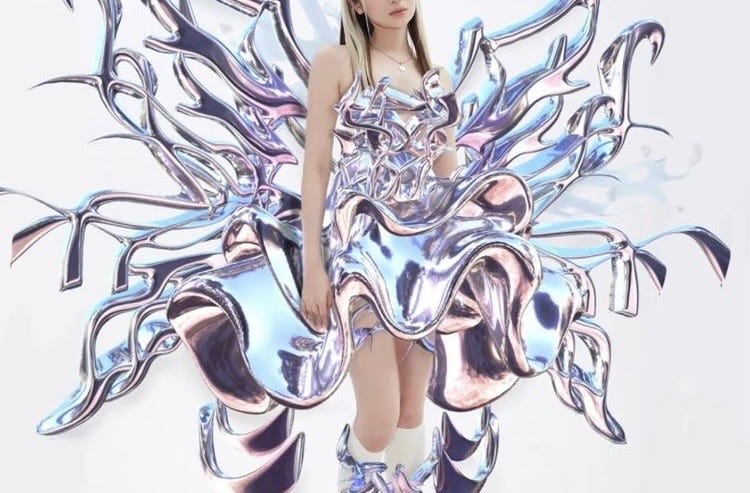Fashions Obsession With Virtual Fantasy
The business of selling fantastical possibilities and virtual fantasies

Fashion has stepped into the virtual realm. In digital-led fashion spaces, avatars reign supreme and personal style takes on a whole new meaning. It's a place where people have found solace as they can reinvent themselves however they see fit, and express their creativity without limitations. Forget the constraints of the physical world; we're talking extravagant, out-of-the-comfort-zone modes of self-expression that are innovative and a little trippy.
In this virtual playground, wearability is a foreign concept. Sure, people experiment online, but do they rock these bold outfits IRL? My guess is most of these looks never move off of the confines of a laptop. But fear not, because 3D and AI tools have made it easier for digital creators and style enthusiasts to push fashion boundaries. And if you were in doubt about how far this could go, let me remind you of the AI-generated image of Pope Francis sporting a Balenciaga-style puffer jacket spreading like wildfire across the Internet. A sight I never expected to see.
The beauty of our online selves lies in our ability to embrace the ever-evolving nature of our identities in a way that feels true at that moment in time. Unlike traditional social media platforms, which often coerce us into presenting a perfectly curated, polished version of what we think we’re supposed to look like, virtual worlds allow us to embrace the multifaceted individuals that we are. Avatars may be a little aspirational, and a little eccentric, but with them we can explore and experiment with sartorial modes of expression that may not be feasible in our everyday lives.
Video games have played a pivotal role in this cultural shift. With brands recognising the power virtual spaces have to engage audiences, collaborations between fashion and gaming have become the next big thing. Marc Jacobs and Valentino designing outfits for Animal Crossing? Louis Vuitton releasing a commemorative game? North Face and Gucci unveiling a Pokémon Go game featuring digitised versions of their collections? It's all going down in the world of fashion and gaming.

But let's not limit the virtual fantasy fashion revolution to avatars and gaming alone. It's a rich and expansive subculture full of forward-thinking communities, and it's a world where imagination and creativity know no bounds. Virtual fashion may exist for stylistic performance and self-expression, but it can free people from the constraints of physical reality. And digital design, rendering digital clothes onto real people, and getting creative with avatars are only part of this ever-expanding realm.
In this new world, the rules are a little different. Realism is not the goal; it's all about pushing boundaries and embracing the fantastical. The Fabricant, a Dutch digital design house, is one business at the forefront of this movement, democratising fashion by co-creating with users and embracing "collective intelligence." They're breaking free from trends, seasonality, and sizing, opening up a dialogue that allows designs to evolve in this continuous feedback loop.
The beauty of this virtual fashion phenomenon also lies in its accessibility. Unlike the traditional fashion landscape, which is elitist and exclusive, the virtual fashion scene welcomes creatives, designers and artists from all backgrounds. It's a space where people without formal fashion training can create collections and thrive, with minimal financial resources and backing, and it's a space that's kickstarting a revolution where two industries with different interests and end goals have come together as passionate collaborators.
Even big players like H&M are jumping on the bandwagon, with the fast fashion behemoth dropping a collection in 2022 that combined the craftsmanship of high fashion with the fantasy of virtual wardrobes. Inspired by the immersive potential of the Metaverse and the tactile nature and depth of our physical world, its ready-to-wear collection blurred the lines between reality, fantasy and escapism.
"The increasingly virtual dimension of fashion creates exciting future opportunities for H&M, allowing us to create vibrant, bold and daring virtual counterparts to our physical collections. In addition to the endless creative possibilities, it also allows us to propose a more sustainable and inclusive fashion vision that can be accessed by anyone, anywhere in the world," said Ann-Sofie Johansson, creative advisor at H&M.
Fashion is in the business of selling endless possibilities. Virtual fashion may seem like a distant or foreign concept, and few of us will be brave enough to try out virtual dress-up looks offline, but internet trends and tech advancements are only going to get more sophisticated, which will influence what we wear, everywhere. The future of fashion is like a simulation of reality. Maybe one day we'll all be strutting our stuff in pixelated couture, leaving the physical world in awe of our digital dexterity.
Share this post, feel free to comment, and subscribe to Fashion Tingz to keep the conversation going.



